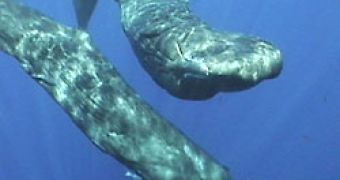Toothed whales represent the diving champions of all air-breathing animals. Sperm whales dive at depths of over 1,200 m (3,600 ft) for more than an hour, while Cuvier's beaked whale (a type of toothed whale) holds the record for diving amongst any sea mammal - 1,900 m (6,330 ft), that translate into 190 atmospheres, for one hour and 25 minutes. The bottlenose whales (Hyperoodon) can dive for periods of 2 hours, at depths at 495 m (1,650 ft) in search of cephalopods. Amongst baleen whales, the humpback whale can dive to 250 m (833 ft) for intervals of 20 minutes. However, a new research published in the Naturwissenschaften journal shows, based on signs of the decompression syndrome found in various whale fossils, that ancient whales were not such skilled deep divers.
The decompression syndrome takes place when rapid pressure changes rapidly force out nitrogen gas, in the form of bubbles, from fat and other tissue into the blood vessels, making them burst. With each 10 m (33 ft) of depth, 1 atmosphere of pressure is added. When diving, the gas is forced by high pressure into the tissues but the decompression syndrome can occur too in the case of ascension.
"Such damage would have been common when whales first began plunging into the depths of the ocean. Playing around in the shallows with Flipper is one thing. But going out in the open ocean and diving hundreds and thousands of meters to go and get a fish or a squid, is like going up in space in terms of changes in pressure," said lead author Brian Beatty, of the New York College of Osteopathic Medicine in Old Westbury, US.
The fact that modern whales have evolved means they have found a way of dealing with this. Baleen whales, the largest of all of them, including the blue whale, feed by taking huge gulps of seawater, which is then filtered through their baleens. They do not dive very deep. But toothed whales, like beaked and sperm whales, feed on giant squids in abyssal waters. The two lineages of whales diverged in their evolution about 45 Ma ago.
Modern whales fight against the decompression syndrome by using various methods. Some exhale before a dive to empty their lungs of bubble-forming nitrogen gas (the oxygen is stored in the myoglobin and hemoglobin rich tissues). Others take ample pauses between dives, ascending slowly so that the gas gets out of the tissues gradually, without forming bubbles (some believe that military sonar can scare whales, influencing their diving behavior and provoking the decompression syndrome). In toothed whales, the nitrogen from the blood is absorbed by the fatty substance on the bump of the head (melon).
The team also analyzed samples of ancient and modern whale vertebrae. The gas bubbles formed during the decompression syndrome can male blood vessels burst inside the bone, and those tiny bone lesions that can be detected using X-ray technology. "It's a measure of small regular damage and not necessarily something traumatic," said Beatty.
Out of the 331 modern whale vertebrae, none had signs of decompression syndrome, but some of ancient whale bones did. The more important finding is that baleen and toothed whales appeared to have adapted independently to deep diving. Decompression signs were discovered only in very ancient toothed whales, while more recent baleen whale fossils still displayed damage, thus baleen whales developed their defenses much later (as seen, even their performances pale in comparison to that of toothed whales, even if their larger bodies should probably constitute an advantage).
Common theory has it that the old ancestor of toothed and baleen whales was a deep diver. Unfortunately, said theory is not in any way approached by this research. What this new study does though is that it supports "our long-standing understanding of the different diving habits between baleen and toothed whales. Tagging modern whales as they dive will help researchers understand how their ancestors evolved to cope," Nick Pyenson, a paleontologist at the University of California, Berkeley, US, said to the NewScientist.

 14 DAY TRIAL //
14 DAY TRIAL //